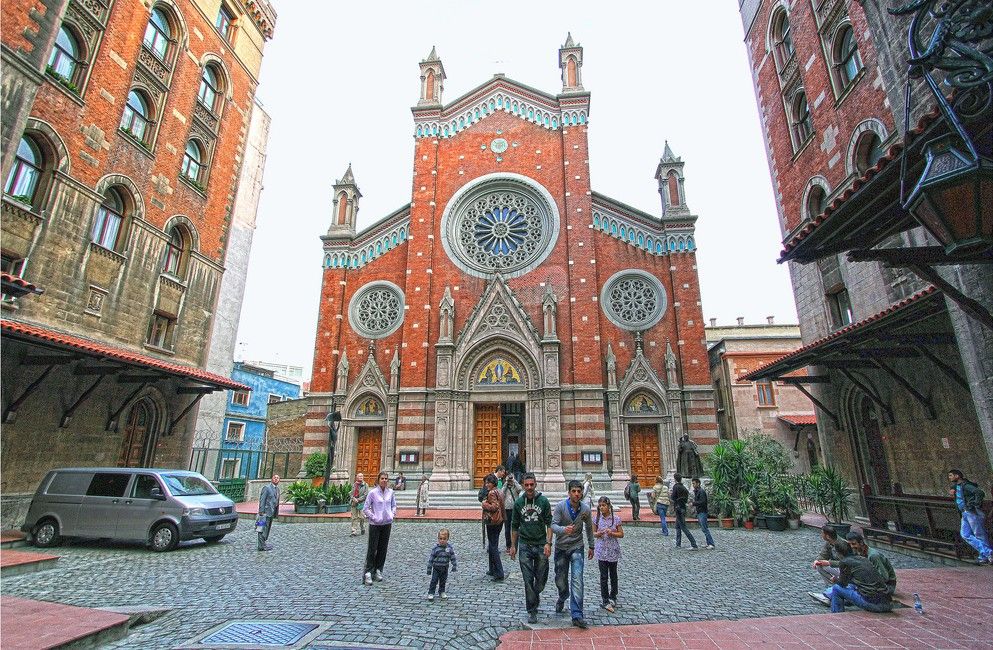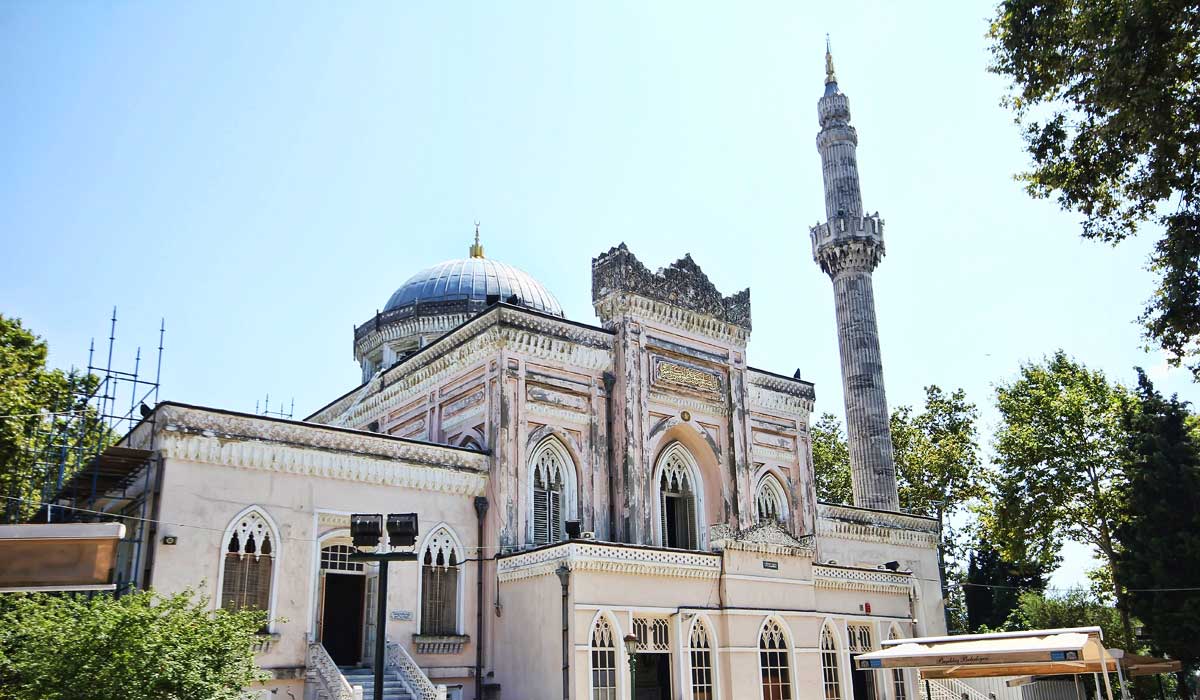The Gothic architecture is a style of architecture that flourished in Europe during the high and late medieval period. It evolved from Romanesque architecture and was succeeded by Renaissance architecture. Originating in 12th-century France and lasting into the 16th century, Gothic architecture was known during the period as Opus Francigenum (“French work”) with the term Gothic first appearing during the latter part of the Renaissance. Neo-Gothic architecture, on the other hand, also referred as Gothic Revival, is an architectural movement that began in the late 1740s in England. Its popularity grew rapidly in the early 19th century, when increasingly serious and learned admirers of neo-Gothic styles sought to revive medieval Gothic architecture, in contrast to the neoclassical styles prevalent at the time. Gothic Revival draws features from the original Gothic style, including decorative patterns, finials, scalloping, lancet windows, hood mouldings, and label stops.
In parallel to the ascendancy of neo-Gothic styles in 19th-century England, interest spread rapidly to the continent of Europe, in Australia, Sierra Leone, South Africa and to the Americas; indeed the number of Gothic Revival and Carpenter Gothic structures built in the 19th and 20th centuries may exceed the number of authentic Gothic structures that had been built previously. Though the number of new Gothic Revival buildings declined sharply after the 1930s, they continue to be built.
The city of Istanbul, although it is perceived as being Eastern oriented, from a cultural point of view, is an important part of the extended phenomena of Gothic and Neo-Gothic architecture, coming under the same umbrella as the developed Western capitals in Europe: London, Paris, Prague, Rome and Brussels. The architecture of Istanbul describes a large mixture of structures which reflect the many influences that have made an indelible mark in all districts of the city. The main stages of architectural development, the city went through, are the following:
- Early Ottoman period (1300-1453)
- Bursa period (1299-1437)
- Classical period (1437-1703)
- Modernization period (1703-1730)
- Tulip period (1703-1757)
- Baroque period (1757-1808)
- Empire period (1808-1876)
- Late period or The National Architectural Renaissance (1876-1922)
In three of the periods mentioned above were built the most important pieces of Gothic and Neo-Gothic architecture in Istanbul, specifically: The Early Ottoman period, the Modernization period, and the Late period. The three monuments that are still preserved and open to visitors in Istanbul are, in chronological order: The Arab Mosque (1325), St. Anthony of Padua Church (originally built in 1725) and Yıldız Hamidiye Mosque (between1884 and1886). A relevant remark is the fact that the Gothic and Neo-Gothic styles in Istanbul did not manifest in the same time as their European counterparts. The latter developed earlier, the difference between the two regions differing from a few decades up until over four centuries. This loss of synchronism was caused by the Ottoman architectural style which was prevalent in the aforementioned historical phases.
I. Arab Mosque (Gothic Style)
Arab Mosque is a mosque in the Karaköy quarter of Istanbul. The building was originally a Roman Catholic church erected in 1325 by the friars of the Dominican Order, near or above an earlier chapel dedicated to Saint Paul. Although the structure was altered during the Ottoman period, it is the only example of medieval religious Gothic Architecture remaining in Istanbul.
The church was converted into a mosque by the Ottomans between 1475 and 1478, during the reign of Sultan Mehmed II, and became known as the Galata Mosque. It was later given by Sultan Bayezid II to Muslim Arab refugees from Al-Andalus who escaped the Spanish Inquisition in 1492 and settled in the Galata neighbourhood of Istanbul (hence its current name, Arab Mosque.)
Erected according to the model of the Italian mendicant order churches of that period, the church had a three-nave rectangular base, with squared-off eastern end and a square sanctuary which is covered by ribbed groin vaults. The Gothic-style portal, lancet windows and the prominent bell tower (which has been transformed into a minaret by the addition of a conical roof) distinguished the building from the Byzantine churches in the city. On the other side, the technique used for the brickwork was local, and alternated small courses of bricks and ashlar.
The flat wooden roof and rather pretty wooden galleries date from the restoration in 1913-1919. On this occasion, the height of the building was lowered, and many Genoese headstones were found. During the same restorations, rests of paintings were also discovered near the Mihrab, but were covered again. In the passage under the belfry, mouldings are still visible, as well as fragments of stones with armorial bearings which were once placed along the wall. On the north side of the building there is a large and attractive courtyard with a şadırvan.
Today, Arab Mosque is the largest mosque on the Galata side of the Golden Horn. It is one of the most interesting mosques in the city due to its early Italian Gothic architectural style and church belfry, which has practically remained unaltered even after being converted into a minaret.
II. Church of St. Anthony of Padua (Neo-Gothic Style)
St. Anthony of Padua Church, alternatively known as the Sant’Antonio di Padova Church, or locally as Sent Antuan, is a basilica and the largest church of the Roman Catholic Church in Istanbul. It is located at İstiklal Avenue No. 171 in the Beyoğlu district.
Along with the Cathedral of the Holy Spirit (1846) in the Harbiye district, St. Louis of the French (1581) and Santa Maria Draperis in Beyoğlu, Sts. Peter and Paul (1841) in Galata, Assumption Church in the Moda quarter of Kadıköy, St. Stephen in Yeşilköy and Bakırköy Church in Bakırköy, St. Anthony of Padua is one of the most important Catholic churches in Istanbul, and among them has the largest community following its Masses.
The original St. Anthony of Padua Church was built in 1725 by the local Italian community of Istanbul, but was later demolished and replaced with the current building which was constructed on the same location. The current St. Anthony of Padua, along with its adjacent buildings (known as the St. Antoine Apartmanları) on İstiklal Avenue, was built between 1906 and 1912 in the Venetian Neo-Gothic style, and was likewise edifice by the local Italian community of the city, mostly of Genoese and Venetian descent, who amounted to 40,000 people at the turn of the 20th century. The building was designed by the Istanbulite Levantine architect Giulio Mongeri, who also designed many other important buildings in Istanbul and Ankara; such as the Maçka Palas in Nişantaşı and the Neo-Byzantine style Karaköy Palas bank building in Karaköy (Galata), Istanbul; as well as the first headquarters of Türkiye İş Bankası in Ankara.
The church is considered a minor basilica, and is run by Italian priests. Saturday Mass is in Italian and begins at 19:00, Sunday Mass is 9:30 in Polish, 10:00 in English and 17:00 in Turkish, and Tuesday Mass is in Turkish and begins at 11:00. Weekday Masses are in English at 8:00.
Together with the churches of St. Mary Draperis, also on İstiklal Caddesi, and of SS. Peter and Paul in Galata, it was one of the three Levantine parishes in Beyoğlu.
Pope John XXIII preached in this church for 10 years, when he was the Vatican’s ambassador to Turkey before being elected as pope. He is known in Turkey with the nickname “The Turkish Pope” because of his fluent Turkish and his often expressed love for Turkey and the city of Istanbul.
III. Yıldız Hamidiye Mosque (Neo-Gothic Style)
The Yıldız Hamidiye Mosque also called the Yıldız Mosque , is an Ottoman imperial mosque located in Yıldız neighbourhood of Beşiktaş district in Istanbul, Turkey, on the way to Yıldız Palace. The mosque was commissioned by the Ottoman sultan Abdul Hamid II, and constructed between 1884 and 1886. The mosque was built on a rectangular plan and has one minaret. The architecture of the mosque is a combination of Neo-Gothic style and classical Ottoman motifs. A bronze colonnade erected by Abdul Hamid II in Marjeh Square of Damascus, Syria bears a replica statue of the Yıldız Mosque on top.
On 21 July 1905, members of the Armenian Revolutionary Federation attempted to assassinate Abdul Hamid II by placing a horse carriage bomb in front of the mosque, an event known as the Yıldız assassination attempt. Although the bomb failed to kill the sultan due to an unforeseen delay, it killed 26 others and wounded 58 more. The attempt was in response to the pogroms and massacres against Armenians and other minorities of the Ottoman Empire carried out by Abdul Hamid II’s government, the Hamidian massacres.
Aside from the Gothic and Neo-Gothic styles, the architecture inside the city proper contains buildings, statues, and functional constructions which came also from Byzantine, Genoese, Ottoman, and modern Turkish sources. The city has many architecturally significant entities. Throughout its long history, Istanbul has acquired reputation for being a cultural and ethnic melting pot. As a result, there are many historical mosques, churches, synagogues, palaces, castles and towers to visit in the city.
General Sources:
-
books.google.ro
-
books.google.ro
-
books.google.ro
-
H. MORDTMANN, The Encyclopedia of Islam, Leiden Publishing, New York, 1986.
-
Raymond JANIN, La Géographie Ecclésiastique de l’Empire Byzantin, Institut Français d’Etudes Byzantines, Paris, 1953.



